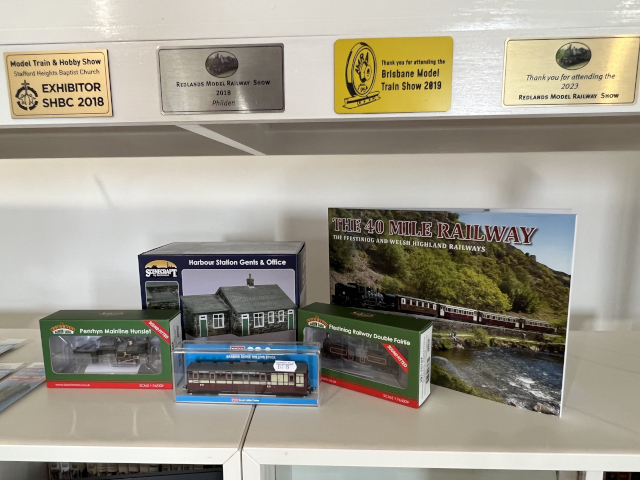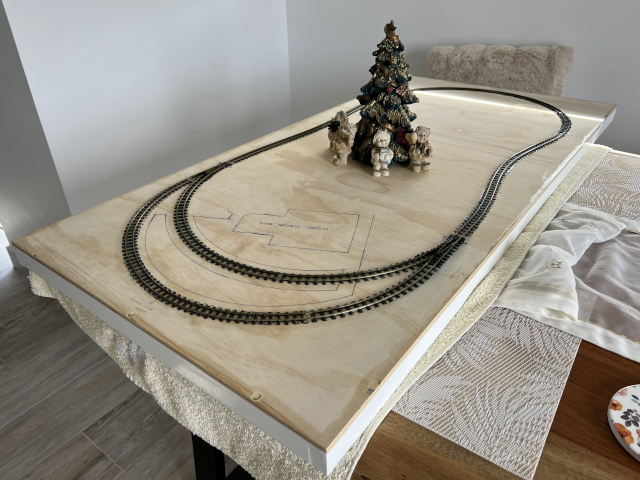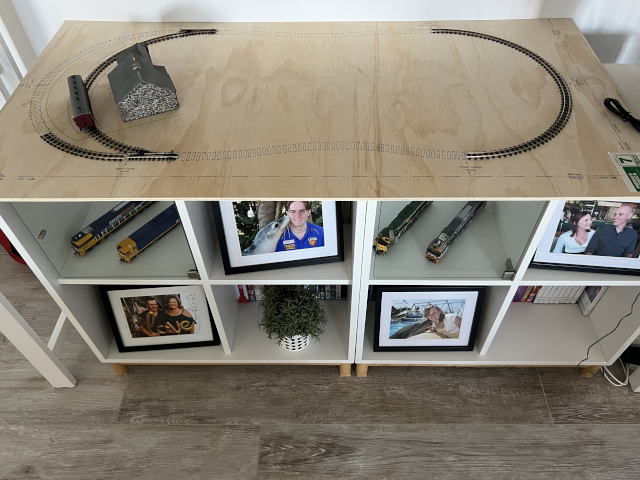The only way to test the track and officially run the first train on Bryn Nadolig, was to wire the layout and connect the feeder wires to the DCC plate that I had pre-built in one corner of the layout’s fascia. To do that, I had to temporarily remove the NCE receiver panel from Philden Beach, which was as simple as unscrewing the plate and removing the plug that houses the positive and negative feeder wires.
Transferring the NCE Power Cab system from one layout to the other was easy. With the NCE panel now screwed into the pre-built slot in the corner of Bryn Nadolig, (see post breaking ground on Bryn Nadolig), I connected the positive and negative feeder wires into the same plug and pressed it in place from beneath the layout. Simple.
 |
| I’m transferring my current NCE DCC system over onto the smaller layout. |
The receiver panel looks neat and tidy once fastened into position on my OO9 layout and will operate exactly as it has on my current HO scale layout. The cost-saving benefit of carrying the NCE system over onto the smaller layout played a key part in my decision when listing Philden Beach for sale, (I simply couldn’t justify buying a second unit just to offer the other layout for sale complete with a DCC system), but the advantage for the potential buyer is that the staging shelf fascia is all pre-built for an NCE Power Cab system to slot straight into straight out of the box.
 |
| And we’re away! My Ffestiniog Railway Double Fairlie became the first engine to traverse the layout. |
In wanting to have this layout up and running before the sale of my current one, the small layout was carried down the three flights of stairs into the garage to have the wires soldered, track painted and all the smelly stuff with paints and glues seen to before it came back upstairs. That was 3 weeks ago, and I have already put a 5-part reveal video up via the Phillcreations Instagram feed. So, here’s a few catch-up photos as I skip ahead to the next post I have planned.
 |
| The track was hand painted and weathered for its frosty winter theme. |
 |
| And the train ran around the layout for a couple of hours while testing all the clearances. |
The wiring for this layout is going to be a rather simple affair, with the main loop and passing siding all wired into the same positive and negative feeders wires that connect into the DCC plug that itself connects at the back of the DCC receiver panel. And that’s it. No auxiliary wires. No toggle switches. Nothing else.
But… they are all things covered in my book Model Railway Trackside Tips. [enter shameless self-promotional plug here].
If you haven’t got a copy in your library, then please consider adding this book as an easy, advertorial-free reference book to cover all of the track basics of the hobby. It is the sort of book I wish I had when I started out in the hobby 45 years ago, and a series of books I am proud to leave behind for the next generation to learn from.
So, there you have it. Trains were up and running for a lengthy afternoon of troubleshooting, before I got to work on the scenery, structures and station area that will be the feature of this small affair. Pleasantly there were zero issues to report. Even more pleasant were the sounds of the small Welsh locomotives.
The DCC button functions on the Bachmann narrow gauge locomotives operate completely different to the sound functions of my Auscision Australian HO locomotives that I’ve been accustomed to for the past 5 years! It is going to take some time to get my head around the F8’s, F1’s and all the rest, without referring to the fold out piece of paper that came inside the box, (I only discovered that when it came time to pack the locomotive away!).
I’m happy to say that I’m already totally immersed in the world of Welsh narrow gauge. When it came down to purely a size issue moving forward in the hobby, these little OO9 locos sure pack a whole lot of charm into such a small size! The only issue for the time being is having to move the DCC receiver plate between the two layouts until the sale of Philden Beach is finalised. Then the NCE Power Cab DCC sound system can stay put on Bryn Nadolig, and hopefully give me many years of trouble-free running.
So convinced am I that this will be the last layout I build, that I’ve already started bagging up bundles of all the leftover HO scale detail parts, structures, bits and bobs, and selling them on eBay, (the link is on the drop-down menu on the left of screen). I haven’t been able to do it all in one hit, so keep checking my new listings as I countdown to farewelling Philden Beach and my days of modelling in Australian HO scale.
Until next time!
See also; Keeping within 1st radius and The road to Bryn Nadolig




